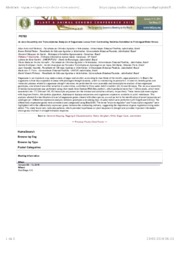de novo Assembly and transcriptome analysis of sugarcane leaves from contrasting varieties submitted to prolonged water stress.
de novo Assembly and transcriptome analysis of sugarcane leaves from contrasting varieties submitted to prolonged water stress.
Author(s): BELESINI, A. A.; TELLES, B. R.; CASTRO, G. M. de; GIACHETTO, P. F.; VANTINI, J. da S.; CARVALHO, F. M. de S.; CARLIN, S. R.; CAZETTA, J. O.; FERRO, M. I. T.; PINHEIRO, D. G.
Summary: Sugarcane is an important crop, major source of sugar and alcohol, accounting for two-thirds of the world's sugar production. In Brazil, the sugarcane culture has expanded to areas with prolonged drought seasons, which is constraining its production. In order to identify genes and molecular process related to sugarcane drought tolerance, we performed de novo assembly and transcriptome analysis of two sugarcane genotypes, one tolerant and other sensitive to water stress, submitted to three water deficit condition (30, 60 and 90 days). The de novo assembly of leaves transcriptome was performed using short reads from Illumina RNA-Seq platform, which produced more than 1 billion reads, which were assembled into 177,509 and 185,153 transcripts sequences for the tolerant and sensitive cultivars, respectively. These transcripts were aligned with Sorghum bicolor, Miscanthus giganteus, Arabidopsis thaliana sequences and sugarcane sequences available in public databases. This analysis allowed the identification of a set of sugarcane genes shared with other species, as well as led to the identification of novel transcripts not cataloged yet. Differential expression analysis between genotypes and among days of water deficit were performed with EdgeR and DESeq. The differentially expressed genes were annotated and categorized using Blast2GO. The terms "enzyme regulator" and "transcription regulator" were highlighted within the differentially expressed genes between the contrasting cultivars, suggesting the importance of gene regulation during water deficit. This study found new molecular patterns, which provided hypotheses on plant response to drought and provided important information about genes involved in drought tolerance response.
Publication year: 2016
Types of publication: Abstract in annals or event proceedings
Observation
Some of Embrapa's publications are published as ePub files. To read them, use or download one of the following free software options to your computer or mobile device. Android: Google Play Books; IOS: iBooks; Windows and Linux: Calibre.
Access other publications
Access the Agricultural Research Database (BDPA) to consult Embrapa's full library collection and records.
Visit Embrapa Bookstore to purchase books and other publications sold by Embrapa.

